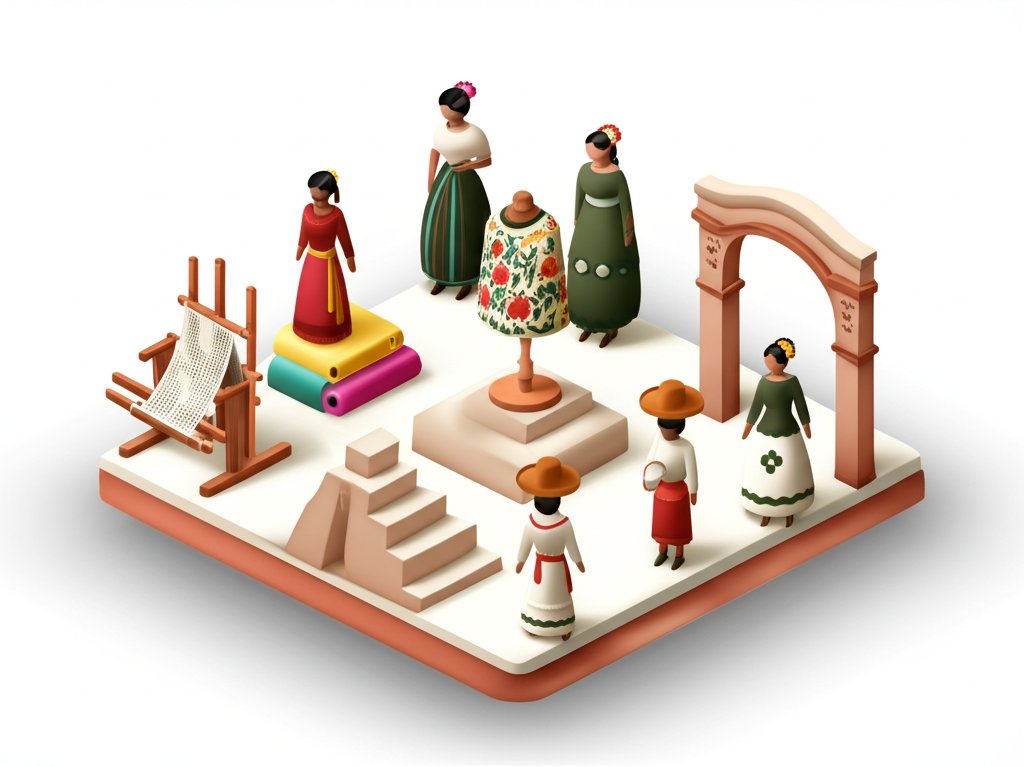The vibrant hues, intricate embroidery, and flowing silhouettes of traditional Mexican dress tell a story far deeper than mere aesthetics. They are living artifacts, textiles woven with the threads of ancient civilizations, colonial influences, revolutionary spirit, and contemporary innovation. To truly understand Mexico, one must delve into the traditional Mexican dress history, a captivating journey through time that reveals the soul of a nation. This article will guide you through the rich mexican fashion history, exploring the evolution of its garments, the profound mexican clothing culture they represent, and the enduring legacy that continues to inspire global fashion today. Prepare to discover the vibrant history of mexican fashion and the cultural narratives stitched into every fold.
The Roots of Mexican Fashion: Pre-Columbian Era (Before 1521)
Long before European contact, Mexico’s diverse indigenous civilizations cultivated sophisticated clothing traditions. These garments were not just for covering the body; they conveyed social status, religious beliefs, regional identity, and the wearer’s connection to the natural world. The traditional Mexican clothing history truly begins here, with a remarkable ingenuity in materials and design.
Materials and Methods: Weaving Ancient Threads
The ingenuity of pre-Hispanic cultures was evident in their textile production. Lacking domesticated sheep for wool, they mastered natural fibers.
The backstrap loom’s enduring presence in indigenous communities highlights the importance of understanding the history of dressmaking and textile arts, echoing similar evolutions documented in our broader exploration of dressmaking history.
Indigenous Garments: Form, Function, and Symbolism
Pre-Columbian attire was generally simple in form, allowing the textile’s patterns and colors to speak volumes.
Regional Diversity Before Conquest
Even in the pre-Columbian era, traditional Mexican clothing history was marked by incredible regional diversity. The Maya in the south developed distinct styles, often utilizing intricate brocade weaving. The Aztecs in the central highlands had their own system of sumptuary laws dictating who could wear what, based on social rank. The Mixtecs and Zapotecs in Oaxaca were renowned for their vibrant dyes and complex designs. Each community’s clothing was a unique identifier, a visual language understood by all.
A Tapestry of Influence: The Colonial Period (1521-1821)
The arrival of the Spanish in the 16th century brought a profound transformation to mexican fashion history. While indigenous traditions persisted, a new era of cultural synthesis began, forever altering the landscape of traditional Mexican dress history.
European Materials and Techniques Transform Traditional Mexican Clothing
The Spanish conquest introduced new materials, tools, and stylistic conventions.
The Birth of Iconic Styles: Mestizo Fashion
The mixing of indigenous and European sartorial traditions gave rise to unique “mestizo” styles, a hallmark of traditional Mexican dress history.
mexican clothing culture and womanhood.Social Status Reflected in Attire
During the colonial period, clothing continued to denote social hierarchy, but with new layers of complexity. Spanish-born elites wore European high fashion, while criollos (Mexicans of Spanish descent) adopted similar styles, sometimes subtly incorporating local elements. Mestizos developed their unique hybrid styles, and indigenous populations, while often maintaining traditional garments, might adapt elements like lacework or new colors.
Forging a National Identity: Post-Independence to the Mexican Revolution (1821-1920s)

After gaining independence from Spain in 1821, Mexico embarked on a quest for self-definition, and clothing played a crucial role in forming a distinct mexican fashion history. This period saw a conscious effort to move away from purely European styles and embrace unique national aesthetics.
The Rise of a Distinctly Mexican Fashion History
The 19th century witnessed the emergence of clothing explicitly recognized as “Mexican.” While European fashion trends still held sway in urban centers, especially among the wealthy, a deeper appreciation for indigenous craftsmanship and local styles began to take root. Artists and intellectuals looked to the country’s diverse regions for inspiration, elevating traditional garments from rustic peasant wear to symbols of national character. The China Poblana dress, for instance, gained significant popularity as an emblem of Mexican womanhood, appearing in folklore and art.
The Mexican Revolution and the Resurgence of Traditional Dress
The Mexican Revolution (1910-1920) was a pivotal moment in the traditional Mexican dress history. In a period of profound social and political upheaval, there was a powerful resurgence of interest in traditional attire. This was not merely a fashion trend but a profound act of cultural reclamation for the mexican clothing culture.
Embracing Indigenous Aesthetics as National Pride
Following the Revolution, the post-revolutionary governments actively promoted indigenous culture as the foundation of Mexican identity. This cultural nationalism led to designers, artists, and even political figures incorporating indigenous motifs and garment styles into their work and public appearance. Frida Kahlo, for example, famously adopted traditional Tehuana dress, elevating it to a global symbol of Mexican strength and artistry. This period firmly cemented indigenous clothing as a cornerstone of the history of mexican fashion.
Modern Mexican Fashion: Blending Heritage and Global Trends

Today, mexican fashion history continues to evolve, showcasing a dynamic interplay between deep-rooted traditions and global contemporary influences. Modern Mexican fashion is a vibrant testament to adaptability, creativity, and an unwavering commitment to cultural heritage.
Contemporary Traditional Mexican Dress: Preservation and Innovation
While many traditional garments are still worn daily in rural indigenous communities, their role has expanded.
history of mexican fashion remains relevant and celebrated.The Enduring Power of Mexican Clothing Culture
The mexican clothing culture is powerful because it’s deeply symbolic. Each garment, each stitch, often carries meaning.
Key Elements of Modern Mexican Fashion
Modern mexican fashion history is characterized by several distinguishing features:
The Soul of the Fabric: Materials, Colors, and Craftsmanship
Beyond historical periods and stylistic shifts, the very essence of traditional Mexican clothing history lies in its fundamental components: the materials, the colors, and the unparalleled craftsmanship. These elements are the bedrock of mexican clothing culture.
From Agave to Silk: Evolution of Textiles
The journey of Mexican textiles illustrates a remarkable adaptation and continuity.
traditional mexican clothing history.The Language of Color: Symbolism in Mexican Dress
Colors in Mexican garments are rarely arbitrary; they speak a vibrant language tied to nature, spirituality, and identity.
mexican clothing culture.The Art of Embroidery and Adornment
Embroidery is arguably the most recognizable and celebrated aspect of traditional Mexican dress history. It’s more than decoration; it’s a storytelling medium, a ritual, and a skill passed down through generations.
history of mexican fashion.Conclusion
From the meticulously woven cotton of ancient civilizations to the bold, embroidered statements of today’s designers, the traditional Mexican dress history is a rich and dynamic narrative. It is a story of resilience, adaptation, and unwavering cultural pride. Each huipil, rebozo, and charro suit is a thread in the intricate tapestry of mexican clothing culture, reflecting centuries of mexican fashion history and the vibrant spirit of its people. By understanding the history of mexican fashion, we gain a deeper appreciation for the artistry, the symbolism, and the profound cultural heritage that continue to shape Mexico’s identity. These garments are not just historical relics; they are living traditions, constantly evolving while staying true to their roots, inviting us to celebrate the beauty and depth of Mexico’s sartorial legacy.
FAQ
Q1: What materials were commonly used in traditional Mexican clothing before the Spanish arrived?
A1: Before the arrival of the Spanish, traditional Mexican clothing history shows that garments were primarily made from natural fibers like cotton, agave (maguey) fibers, and certain types of tree bark. These materials were skillfully processed and woven, often using a backstrap loom, to create functional and symbolic attire.
Q2: How did European influence change traditional Mexican dress?
A2: European influence, particularly during the Colonial period, significantly impacted mexican fashion history. New materials like wool and silk were introduced, along with the pedal loom, which allowed for faster production. European tailoring techniques led to more fitted and structured garments, and styles like the charro suit and the China Poblana dress emerged as unique blends of indigenous and European aesthetics.
Q3: What are some iconic traditional Mexican garments for women and men?
A3: For women, the huipil (a loose-fitting, embroidered tunic) and the rebozo (a versatile shawl) are among the most iconic, each with countless regional variations reflecting mexican clothing culture. For men, the charro suit (the elegant attire of the Mexican cowboy) and the sarape (a colorful blanket-like shawl) are prominent examples, embodying the rich history of mexican fashion.
Q4: What role does color play in traditional Mexican clothing?
A4: Color plays a crucial and symbolic role in traditional Mexican clothing. Vibrant colors like red, orange, yellow, green, and blue are frequently used, often reflecting the country’s natural landscapes, spiritual beliefs, and celebratory spirit. Earthy tones also connect to the land and its resources. The specific combinations and shades can also denote regional identity and cultural messages within the mexican clothing culture.
Q5: How did the Mexican Revolution affect traditional dress?
A5: The Mexican Revolution was a pivotal moment for traditional Mexican dress history. It led to a powerful resurgence and re-evaluation of indigenous and traditional clothing. Wearing these garments became a symbol of national pride and resistance against foreign influences, fostering a sense of shared identity and unity across the nation. This period cemented many traditional styles as integral to mexican fashion history.










